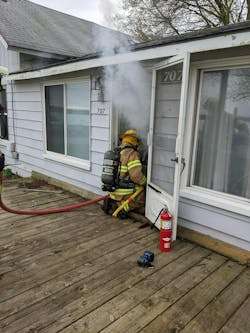Sparking Excellence in Firefighting Through Simulation Training
Although the power of simulation training is evident, there is a notable lack of comprehensive research that validates its effectiveness within the fire service. Nevertheless, the existing studies, such as the one that involves the Allen, TX, Fire Department, are promising, indicating a 22 percent increase in decision-making competency post-simulation training. This statistic is a testament to the real-world effect of simulation training on the critical decisions that firefighters make daily.
My research contributes data-driven evidence of the transformative potential of simulation training. Armed with this knowledge, departments can advance toward a path of heightened competence and professionalism, ensuring that they’re prepared for whatever challenges that they might face.
The research
In the fire service, we respond to a wide range of emergency and nonemergency situations. Of course, these can be hazardous and have the potential to cause injury or death. According to the U.S. Fire Administration, 141 firefighters lost their life on duty in 2021, with 92 of those fatalities occurring during emergency response activities. The NFPA conducted research to develop recommendations to promote safety and reduce the number of fatalities and injuries annually. One of the most prominent recommendations in this report was to improve training and education for all members who are involved in emergency operations.
I wanted to identify whether there was a correlation between simulation training (independent variable) and decision-making abilities, learner satisfaction and job satisfaction (dependent variables). The research study design that was used was a convergent mixed-methods research model that was composed of qualitative and quantitative research, to produce more comprehensive results. Using multiple research approaches allowed triangulation of data and strengthening of the validity and reliability of the research findings. This method also provided a more detailed examination of the complex relationship of the variables to understand the subject better.
Although it was preferable to explore a larger sample population from around the country for the study, because of accessibility issues, firefighters who operate in the state of Michigan who are members of Michigan Professional Fire Fighters Union were studied. This provided the best opportunity to increase the confidence level of findings, explore a diverse population from around the state and concentrate on one particular demographic. The study was composed of 78.1 percent career departments and 21.9 percent combination departments.
All participants were required to complete an informed consent form, and all research was carried out under the internal review board of Apollos University. Participants first were asked basic background information, including type of department, the district of which they were a member, years of service, whether they ever participated in simulation training or facilitated debriefings, and what type of simulation training they used.
The question regarding the kind of simulation training is a little tricky, because there are no clear definitions for differentiating the various simulation training methods. Therefore, some basic definitions that derive from Queen’s University’s “Simulation-based Experiential Learning Faculty Toolkit” and “Virtual Simulation in Nursing Education: A Systematic Review Spanning 1996 to 2018” (Cynthia L. Foronda et al, Simulation in Healthcare, 2020) were used to minimize confusion.
Simulation training was defined as simulation-based learning that’s a form of experiential learning, where learners are tasked to solve complex problems in controlled environments through replicated “real-life scenarios.” Simulation-based experiential learning allows learners to absorb knowledge and practice skills in a realistic but simulated, safe environment.
Simulation training then was broken into four categories:
- Physical simulation training, which is a form of experiential learning that uses physical replicas or models of real-world objects or environments to train learners in various skills and tasks.
- Discussion-based simulations are a form of experiential learning that uses structured dialogues and debates to train learners in critical thinking, communication and problem-solving skills.
- Operations-based simulations are a form of experiential learning that uses realistic, immersive replications of real-life work processes, scenarios, tasks and tools.
- Virtual simulation training is offered on a computer, the internet, or a digital learning environment, including virtual reality, augmented reality and mixed-reality simulation training.
Based on the results from the study, 95.3 percent of respondents participated in some form of simulation training. This percentage doesn’t identify which types of simulation training were used predominately. However, each respondent was required to select the type(s) of simulation training that they used. The most-used type of simulation training was physical simulation training (85.9 percent), followed by discussion-based simulations (76.6 percent), operations-based simulations (56.3 percent) and virtual simulation training (28.1 percent).
The next question sought to identify how regularly respondents participated in simulation training. Based on the responses, only 39 percent participated on average more than one time per year in any form of simulation training.
Quantitative analysis
In this section, a five-point Likert scale was used to gauge respondents’ experiences, and the results were analyzed using descriptive statistics.
The data identified that participants generally agree that simulation training, with a mean score of 4.15, is valuable and should be adopted more widely. Most participants agreed that simulation training increased their job satisfaction (mean score of 3.91) and improved their decision-making abilities (mean score of 4).
Qualitative data
These data were gathered through open-ended questions to reveal respondents’ views of simulation training and facilitated debriefings as industrywide best practices. They highlighted the benefits, such as allowing firefighters to practice perishable skills, making reactions more automatic, and helping less experienced firefighters to understand their senior firefighters’ processes and decision-making skills.
Respondents preferred hands-on simulation training, noting its value in enhancing job satisfaction and its role in safe mistake-making and explaining the importance of each training piece. There was strong support for the broader adoption of simulation training and facilitated debriefings, with some participants suggesting regular drills or simulations to increase proficiency on the fireground, particularly for high-risk/high-reward events.
High-risk profession comparables
Recent studies in other high-risk professions indicate a positive correlation between simulation training and job satisfaction.
Dylan Gagnon’s 2022 “The Application of Virtual Reality in Firefighting Training” highlighted that virtual training enhances job satisfaction, which is a sentiment that was shared by participants in diverse simulation training programs.
“Exploring the relationship between simulation-based team training and sick leave among healthcare professionals: a cohort study across multiple hospital sites” (Anders Schram et al, BMJ Journals, October 202) further supports this, showing reduced sick leave usage among healthcare professionals who are engaged in simulation-based team training.
This trend is consistent across high-stress fields, suggesting that simulation training benefits job satisfaction. This information can be valuable for fire departments, because the fire service is experiencing significant difficulties with recruitment and retention, and job satisfaction can be one way to bolster employee retention.
The effectiveness of simulation training extends to decision-making abilities.
Kurt Hall’s 2010 study, “The Effect of Computer-Based Simulation Training on Fire Ground Incident Commander Decision Making,” found that computer-based simulation training improves fireground incident commanders’ decision-making efficiency. Steven Gillespie’s 2014 research, “Fire Ground Decision-Making: Transferring Virtual Knowledge to the Physical Environment,” corroborates this, linking simulation training to increased confidence in incident command and management. Recent findings by Joy VerPlanck in “The effects of simulator training on the development of creative thinking in law enforcement officers” demonstrate that simulation training minimizes cognitive load and accelerates decision-making, thereby boosting confidence.
Needed change
As we look to the future, embracing simulation training as a cornerstone of firefighter development will be crucial in addressing recruitment and retention challenges and, ultimately, in safeguarding the well-being of communities.
Despite 81.3 percent of firefighters who operate in the state of Michigan who are members of Michigan Professional Fire Fighters Union who responded to the survey recognizing simulation training as an industry best practice, 60 percent of those same people engage in such training less than once annually. This gap demonstrates a critical need for change and that departments must prioritize the integration of simulation training into their regular training schedules. This approach not only has the potential to enhance job satisfaction and decision-making abilities but also to equip firefighters to navigate the complexities of real-world scenarios in a safe environment.
Considering the compelling evidence, departments must prioritize the integration of simulation training into their regular training schedules. Not only does this approach have the potential to improve job satisfaction and decision-making abilities, but it also prepares firefighters for the complexities of real-world scenarios by allowing them to gain experiences in a safe environment.
About the Author

Philip Duczyminski
Philip Duczyminski is a 28-year fire service veteran who currently serves as a captain and head of the training division of the Novi, MI, Fire Department. His experience includes working with Western Wayne County HMRT and MI-TF1. As a graduate of the School of Fire Staff and Command at Eastern Michigan University, Duczyminski holds certifications as a Michigan fire instructor and an EMS instructor coordinator. His academic achievements include a bachelor’s degree in fire science, a Master of Business Administration with a concentration in public administration and a doctorate in business administration.
